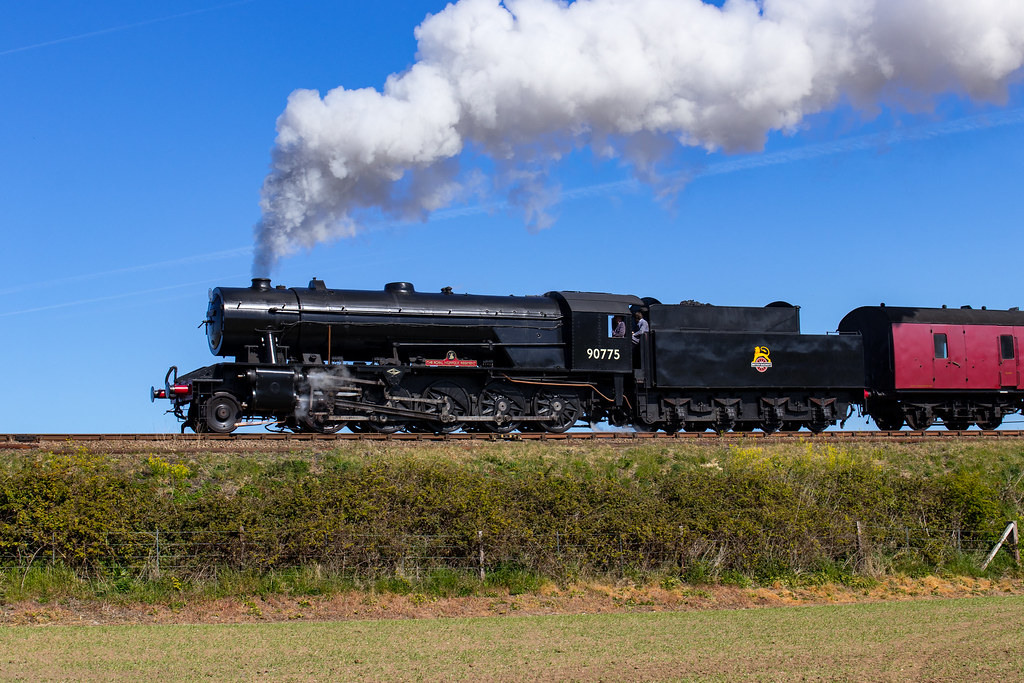#Royal Norfolk Regiment
Text
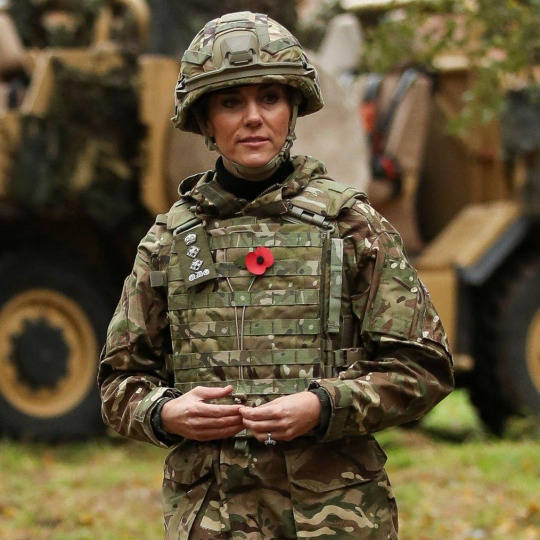

CATHERINE'S STYLE FILES - 2023
8 NOVEMBER 2023 || The Princess of Wales visited the 1st The Queen's Dragoon Guards regiment at the Robertson Barracks at Swanton Morley in Norfolk.
Catherine opted for -
↬ Country Crew Neck Knit in 'Forest Marl' by Holland Cooper
↬ Windproof Camouflage Combat Smock Jacket from the British Army
↬ The Queen's Dragoon Guards Rank Slide from the British Army
↬ Black Turtleneck Sweater
↬ Black Skinny Trousers
↬ Teardrop Hoops with Garnet Charm Earrings by Spells of Love
↬ Paper Poppy Pin by Royal British Legion
↬ Leather Trimmed Suede Ankle Boots from See By Chloé
#catherines style files#style files 2023#british royal family#british royals#royalty#royals#kate middleton#catherine middleton#brf#british royalty#royal#duchess of cambridge#princess of wales#the princess of wales#princess catherine#princess kate#8112023#british army.#1stQueensDragoonGuards23#holland cooper.#spells of love.#teardrop garnet charm earrings.#paper poppy pin.#royal british legion.#see by chloé.#chloé.#rpyal fashion#fashion#style
42 notes
·
View notes
Text
Court Circular | 20th January 2023
Sandringham, Norfolk
The King this morning arrived at Manchester Victoria Railway Station and was received by His Majesty’s Lord-Lieutenant of Greater Manchester (Mrs Diane Hawkins), the Lord Mayor of Greater Manchester (Councillor Donna Ludford) and the Mayor of Greater Manchester (Mr Andrew Burnham).
His Majesty drove to the Northwest hub of Government Communications Headquarters, Heron House, Albert Square, Manchester, and was received by the Director (Sir Jeremy Fleming), before meeting members of staff and viewing a school class taking place.
The King afterwards visited Kellogg’s factory, Park Road, Trafford Park, Stretford, Manchester, to mark the Company’s Centenary in the United Kingdom, and was received by Mr Christopher Silcock (Managing Director of the United Kingdom and Ireland), Mr Timothy McKnight (Manchester Plant Director) and the Mayor of Trafford (Mr Christopher Boyes).
His Majesty toured the Culinary Centre viewing a cooking demonstration before visiting the factory floor.
The King and The Queen Consort this afternoon attended a Reception for representatives from the local community at Bolton Town Hall, Victoria Square, Bolton, and were received by the Mayor of Bolton (Councillor Akhtar Zaman).
Their Majesties later visited Norbrook Community Centre, Withenshawe, Bordley Walk, Wythenshawe, Manchester, and were received by the Owner (Mr Gavin Evans) and Mr Adam Beech (Youth Worker and Programme Lead).
The King and The Queen Consort toured the renovated outdoor area of the Community Centre and the sports facilities before watching young people playing sport and meeting members of the Centre.
Kensington Palace
The Prince of Wales this morning spoke via video link to residents of Australia who have been affected by the recent flooding.
St James’s Palace
Today is the Anniversary of the Birthday of The Countess of Wessex.
St James’s Palace
The Princess Royal, Colonel-in-Chief, The Royal Logistic Corps, this morning visited 9 Regiment at Buckley Barracks, Lower Stanton St Quintin, Wiltshire.
#court circular#princess anne#princess royal#king charles iii#queen camilla#prince of wales#countess of wessex
20 notes
·
View notes
Text
@themidnightcircusshow‘s tags her reblog on this post about Henry V’s facehole made me realise I should write up some thoughts I’d been having about the facehole and the portrait. Henry V’s portrait depicts him in profile and it's usually been interpreted (i.e. by Ian Mortimer, Helen Castor, Michael Livingstone) that this profile view is designed to "hide" the scar and/or is "proof" that when John Bradmore said that the wound was "beside the nose on the left side (iuxta nasum ex sinistra parte)", he really meant his left, rather than Henry's left because the portrait shows his unblemished left side.
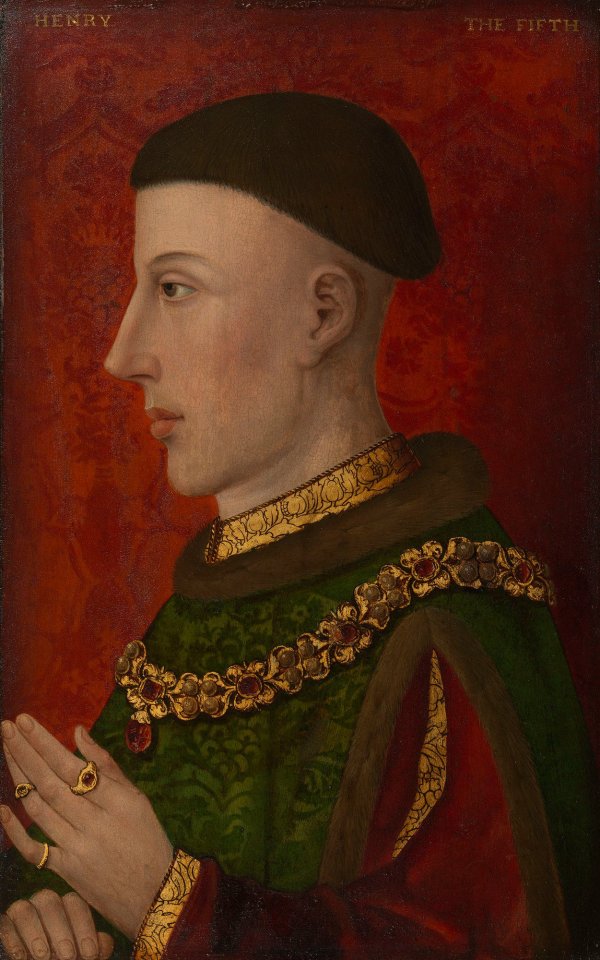
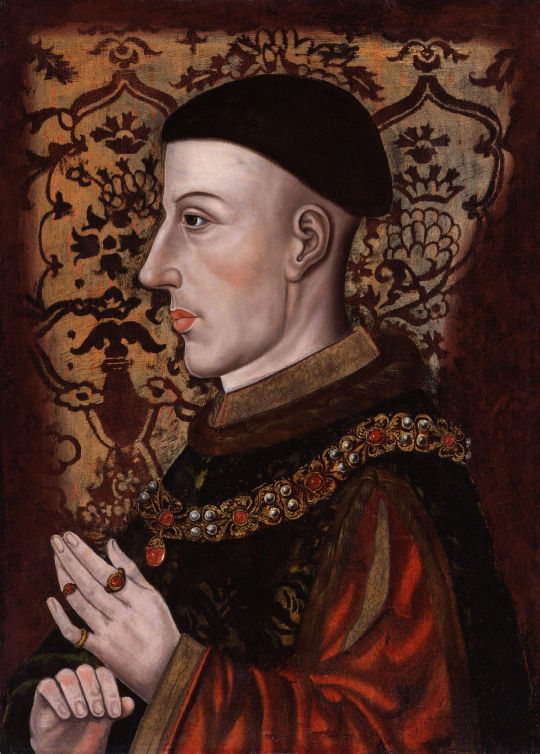
Image: two portraits of Henry V, depicting him in profile that shows the left side of his face. The one on the left (RCIN 403443) is in the earliest known portrait, made 1504 and 1520. The one on the right (NPG 545) is the commonly used portrait, made in the late 16th or early 17th century.
In comparison to other medieval portraits, this side profile view is notable. Richard II is presented face-on while the kings from Henry VI to Henry VII are depicted in three-quarters view (the "towel hat" portrait of Henry IV is a 16th century fake, no reliable likeness of Henry IV has survived outside of his tomb effigy).
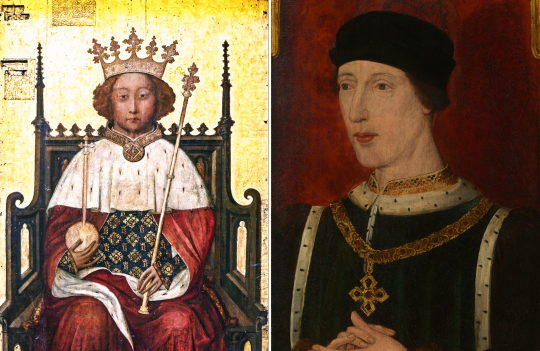
Images: The first is Richard II's "coronation portrait" located in Westminster Abbey. It is the only surviving contemporary portrait of a medieval king. Richard II is depicted facing the viewer front-on. Henry VI from the Royal Collection (RCIN 403442), dated 1504-1520, depicted in three-quarters view.
But the portraits of Henry V all date from the 16th century or later, copies of a now-lost work. This isn't unusual, given that that's true for all medieval kings except Richard II but notable because we do have some contemporary likenesses of Henry V and they show his face from different angles. For instance, manuscripts depictions frequently show his face in three-quarter view (some images shows him face-on) but also from different angles, suggesting they weren't trying to hide one part of his face.

Images: Two images of the then-Prince Henry receiving or gifting Thomas Hoccleve's "The Regiment of Princes". The first is from BL Arundel MS. 38 fol.30v and shows the Prince to the left a kneeling figure, either Hoccleve or John Mowbray, 2nd Duke of Norfolk. It was dated to 1411-1432. The second is from BL Royal MS 17 D VI fol. 40r and shows the Prince to the right of a kneeling figure, either Hoccleve or William FitzAlan, 16th earl of Arundel. It is dated to the second quarter of the 15th century.
Another (potentially? near?) contemporary image is the choir screen at York Minster which depicts all the kings since the Conquest up until Henry VI. It is generally believed to have been commissioned by Henry V but was completed in the reign of Henry VI so it might not be exactly contemporary to Henry. With this one, we can see his whole face and look, no scar, ma!

Image: The statue of Henry V from the choir screen at York Minster.
All of these images are fairly idealised, even generic images which does raise questions of how accurate a likeness they were. At the very least, Henry V probably did not have hair that floofy. None of them are the model for the side-portrait but more importantly, whatever part of his face is hidden or revealed, he is never shown with facial scarring. It's impossible to tell whether the more personalised of these likenesses really looked like him or, for the most part, who commissioned them and what instructions they gave the artist. It's interesting to note that the contemporary Versus rhythmici in laudem Regis Henrici Quinti describes him without mentioning any scar.
But it does suggest that people "dealt with" the scar by ignoring its presence, rather than acknowledging it or making efforts to represent him in ways that would hide the scar (which might actually draw attention to what he wished to hide - cf. how once we knew the seriousness of the wound, attention turned to how his portrait 'hid' it). Which suggests that Henry maybe didn't choose profile-view for his portrait for its ability to hide his scar.
So let's turn back to the portraits of Henry in side-profile. The earliest known portrait was made in 1504-1520. Frederick Hepburn's study of this portrait noted that although most of the costume is accurate, elements are anachronistic and perhaps inauthentic, such as the slashed sleeve (which came into fashion later in the 15th century) and possibly the pomegranate pattern of the cloth-of-gold doublet or undergown. He also noted that the positioning of the hands is strange. The first known examples of the hand posed with the finger curled come from the 1450s paintings of Rogier van der Weyden so it wouldn't be found in an image contemporary to Henry. The single left hand held up upwards is not seen elsewhere and the most similar gesture is both hands raised in prayer. He notes that some later copies of the portrait depict both hands joined in prayer while some other copies I've seen in Catherine Daunt's thesis remove the right hand altogether. He suggests that the hands are altered from the original.
The general consensus from art historians (including Hepburn) has been that the original image was a votive or donor portrait, showing Henry kneeling in prayer before a holy figure. Without the original portrait, it's impossible to know who this figure would be - it might be one of Henry's patron saints (his brother, John, Duke of Bedford, was depicted in the Bedford Hours kneeling to St George), the crucified Christ, the Virgin and Christ, or any other figures of devotion. Francis Minkus speculates that the original may have been placed at Henry's foundations at Syon, and may have served as inspiration for the seal of the Abbess and Convent of Syon. If so, the original portrait likely showed Henry presented to the Virgin and Child by St Bridget of Sweden.
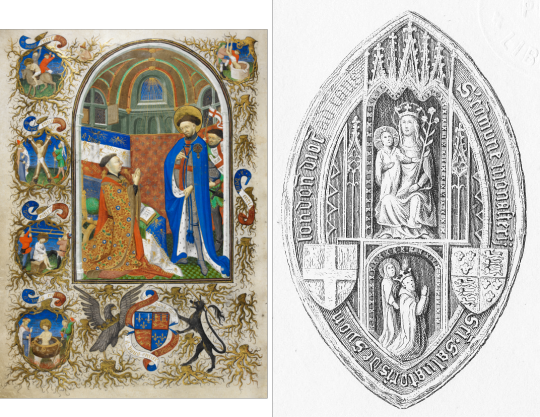
Images: The first image shows John, Duke of Bedford (Henry V's brother) kneeling before St George in the Bedford Hours (BL Add MS 18850, f. 257v). The second image shows an engraving of the Syon seal. On the top is the Virgin holding the infant Jesus, on the bottom is St Bridget presenting a kneeling Henry V. His hands are held upright in prayer. Flanking the bottom image are the arms of St George (left) and the arms of England and France (right).
On a similar note, A. J. Pollard suggests Henry's portrait might have deliberately the Wilton Diptych in homage to Richard II. While Pollard seems to be suggesting that the original portrait was just a portrait of Henry alone, I think it's more likely that it was a donor portrait and it may have been inspired by or modelled off the Wilton Diptych, possibly also serving the same purpose - i.e. the original was a now-lost portable altarpiece.

Image: the inside of the Wilton Diptych (NG4451). It shows John the Baptist, Edward the Confessor and St Edmund presenting a kneeling Richard II (his face in profile) to the Virgin and Child, surrounded by angels.
Or perhaps it was more like the now-destroyed wall-painting of Edward III, Philippa of Hainault and their children at St. Stephen's Chapel in Westminster Palace, showing Edward III and his sons presented by St. George to the Virgin and Child.

Image: Richard Smirke's copy of the the lost wall paintings of St Stephen's chapel, showing St. George presenting Edward III and his sons (1800-11).
The portrait we know probably is the result of the secularisation of the original portrait in the 16th century, perhaps for Henry VII's reputed collection of portraits of every king up to and including himself. Henry V's hands were almost certainly repositioned and it's possible that the background was changed too. Pollard suggested the original profile might have even been flipped - it seems more common for men to be shown kneeling to the left to the figure they're venerating though it's not unknown for them to kneel to the right. The original might have also had Henry wearing a crown that wasn't included since kings are shown wearing crowns in their donor images (cf. the chapel wall painting of Edward III, the Wilton Diptych, the Syon Abbey seal). All of this is unprovable since the original portrait, whatever form it took, however it depicted Henry, has been lost.
But if the original was a donor portrait (as seems likely), then the profile view of Henry is entirely conventional. It doesn't (necessarily) indicate a desire to hide his scar and may not tell us anything about where his scar was located or whether or not Bradmore confused his own left with his patient's left (which does seem a rather elementary mistake for a distinguished surgeon writing an account of what his most famous case). After all, none of the actual surviving contemporary and near-contemporary images of Henry show him in profile or from one accepted angle. It seems that Henry's (and his contemporaries')* preferred method of dealing with his scar in depictions, whether literary or artistic, was to erase it completely.
And none of this tells us how he coped with the scar in real life. Did he really ban people from looking him in the eye? I don't think that was actually feasible for the purpose of hiding his scar since his eyes aren't known to be affected by the injury. It might even make people look at the scar rather than his eyes. Did he just cope with people seeing it? Probably! The alternative is that he a) always wore a mask or b) went around, only ever facing people from his one good side. Seems a bit awkward.
* It's worthwhile noting that while the English chroniclers are predictably quiet about the scar, the French chroniclers are too. Even that account where Henry got pissed at the guy who looked him in the eye.
Sources:
Daunt, Catherine Portrait sets in Tudor and Jacobean England. Doctoral thesis (PhD, University of Sussex, 2015)
Hepburn, Frederick, Portraits of the Later Plantagenets, (The Boydell Press, 1984)
Livingston, Michael, ‘“The Depth of Six Inches”: Prince Hal’s Head- Wound at the Battle of Shrewsbury’, Wounds and Wound Repair in Medieval Culture (Brill, 2015)
Mickus, Francis, "Dieu et mon droit: The Context of Henry V's Self-Representation", The Fifteenth Century Conference (2020)
Pollard, A. J. Henry V: Pocket Giants (The History Press, 2014)
37 notes
·
View notes
Video
90775 at Weybourne por Brian Bilverstone
Por Flickr:
Ex-British Railways locomotive 90775 "The Royal Norfolk Regiment" waiting at Weybourne Station on the North Norfolk Railway ("The Poppy Line") one of England's many heritage railways.
3 notes
·
View notes
Text
Events 1.1
153 BC – For the first time, Roman consuls begin their year in office on January 1.
45 BC – The Julian calendar takes effect as the civil calendar of the Roman Empire, establishing January 1 as the new date of the new year.
42 BC – The Roman Senate posthumously deifies Julius Caesar.
193 – The Senate chooses Pertinax against his will to succeed Commodus as Roman emperor.
404 – Saint Telemachus tries to stop a gladiatorial fight in a Roman amphitheatre, and is stoned to death by the crowd. This act impresses the Christian Emperor Honorius, who issues a historic ban on gladiatorial fights.
417 – Emperor Honorius forces Galla Placidia into marriage to Constantius, his famous general (magister militum) (probable).
1001 – Grand Prince Stephen I of Hungary is named the first King of Hungary by Pope Sylvester II (probable).
1068 – Romanos IV Diogenes marries Eudokia Makrembolitissa and is crowned Byzantine Emperor.
1259 – Michael VIII Palaiologos is proclaimed co-emperor of the Empire of Nicaea with his ward John IV Laskaris.
1438 – Albert II of Habsburg is crowned King of Hungary.
1500 – Portuguese explorer Pedro Álvares Cabral discovers the coast of Brazil.
1502 – The present-day location of Rio de Janeiro, Brazil, is first explored by the Portuguese.
1515 – Twenty-year-old Francis, Duke of Brittany, succeeds to the French throne following the death of his father-in-law, Louis XII.
1527 – Croatian nobles elect Ferdinand I, Archduke of Austria as King of Croatia in the 1527 election in Cetin.
1600 – Scotland recognises January 1 as the start of the year, instead of March 25.
1604 – The Masque of Indian and China Knights is performed by courtiers of James VI and I at Hampton Court.
1651 – Charles II is crowned King of Scotland at Scone Palace.
1700 – Russia begins using the Anno Domini era instead of the Anno Mundi era of the Byzantine Empire.
1707 – John V is proclaimed King of Portugal and the Algarves in Lisbon.
1739 – Bouvet Island, the world's remotest island, is discovered by French explorer Jean-Baptiste Charles Bouvet de Lozier.
1772 – The first traveler's cheques, which could be used in 90 European cities, are issued by the London Credit Exchange Company.
1773 – The hymn that became known as "Amazing Grace", then titled "1 Chronicles 17:16–17", is first used to accompany a sermon led by John Newton in the town of Olney, Buckinghamshire, England.
1776 – American Revolutionary War: Norfolk, Virginia is burned by combined Royal Navy and Continental Army action.
1776 – General George Washington hoists the first United States flag, the Grand Union Flag, at Prospect Hill.
1781 – American Revolutionary War: One thousand five hundred soldiers of the 6th Pennsylvania Regiment under General Anthony Wayne's command rebel against the Continental Army's winter camp in Morristown, New Jersey in the Pennsylvania Line Mutiny of 1781.
1788 – The first edition of The Times of London, previously The Daily Universal Register, is published.
1801 – The legislative union of Kingdom of Great Britain and Kingdom of Ireland is completed, and the United Kingdom of Great Britain and Ireland is proclaimed.
1801 – Ceres, the largest and first known object in the Asteroid belt, is discovered by Giuseppe Piazzi.
1804 – French rule ends in Haiti. Haiti becomes the first black-majority republic and second independent country in North America after the United States.
1806 – The French Republican Calendar is abolished.
1808 – The United States bans the importation of slaves.
1810 – Major-General Lachlan Macquarie officially becomes Governor of New South Wales.
1822 – The Greek Constitution of 1822 is adopted by the First National Assembly at Epidaurus.
1834 – Most of Germany forms the Zollverein customs union, the first such union between sovereign states.
1847 – The world's first "Mercy" Hospital is founded in Pittsburgh, United States, by a group of Sisters of Mercy from Ireland; the name will go on to grace over 30 major hospitals throughout the world.
1860 – The first Polish stamp is issued, replacing the Russian stamps previously in use.
1861 – Liberal forces supporting Benito Juárez enter Mexico City.
1863 – American Civil War: The Emancipation Proclamation takes effect in Confederate territory.
1877 – Queen Victoria of the United Kingdom is proclaimed Empress of India.
1885 – Twenty-five nations adopt Sandford Fleming's proposal for standard time (and also, time zones).
1890 – Eritrea is consolidated into a colony by the Italian government.
1892 – Ellis Island begins processing immigrants into the United States.
1898 – New York, New York annexes land from surrounding counties, creating the City of Greater New York. The four initial boroughs, Manhattan, Brooklyn, Queens, and The Bronx, are joined on January 25 by Staten Island to create the modern city of five boroughs.
1899 – Spanish rule ends in Cuba.
1900 – Nigeria becomes British protectorate with Frederick Lugard as high commissioner.
1901 – The Southern Nigeria Protectorate is established within the British Empire.
1901 – The British colonies of New South Wales, Queensland, Victoria, South Australia, Tasmania, and Western Australia federate as the Commonwealth of Australia; Edmund Barton is appointed the first Prime Minister.
1902 – The first American college football bowl game, the Rose Bowl between Michigan and Stanford, is held in Pasadena, California.
1910 – Captain David Beatty is promoted to Rear admiral, and becomes the youngest admiral in the Royal Navy (except for Royal family members) since Horatio Nelson.
1912 – The Republic of China is established.
1914 – The SPT Airboat Line becomes the world's first scheduled airline to use a winged aircraft.
1923 – Britain's Railways are grouped into the Big Four: LNER, GWR, SR, and LMS.
1927 – New Mexican oil legislation goes into effect, leading to the formal outbreak of the Cristero War.
1928 – Boris Bazhanov defects through Iran. He is the only assistant of Joseph Stalin's secretariat to have defected from the Eastern Bloc.
1929 – The former municipalities of Point Grey, British Columbia and South Vancouver, British Columbia are amalgamated into Vancouver.
1932 – The United States Post Office Department issues a set of 12 stamps commemorating the 200th anniversary of George Washington's birth.
1934 – Alcatraz Island in San Francisco Bay becomes a United States federal prison.
1934 – A "Law for the Prevention of Genetically Diseased Offspring" comes into effect in Nazi Germany.
1942 – The Declaration by United Nations is signed by twenty-six nations.
1945 – World War II: The German Luftwaffe launches Operation Bodenplatte, a massive, but failed, attempt to knock out Allied air power in northern Europe in a single blow.
1947 – Cold War: The American and British occupation zones in Allied-occupied Germany, after World War II, merge to form the Bizone, which later (with the French zone) became part of West Germany.
1947 – The Canadian Citizenship Act 1946 comes into effect, converting British subjects into Canadian citizens. Prime Minister William Lyon Mackenzie King becomes the first Canadian citizen.
1948 – The British railway network is nationalized to form British Railways
1949 – United Nations cease-fire takes effect in Kashmir from one minute before midnight. War between India and Pakistan stops accordingly.
1956 – Sudan achieves independence from Egypt and the United Kingdom.
1957 – George Town, Penang, is made a city by a royal charter of Queen Elizabeth II of the United Kingdom.
1957 – Lèse majesté in Thailand is strengthened to include "insult" and changed to a crime against national security, after the Thai criminal code of 1956 went into effect.
1958 – The European Economic Community is established.
1959 – Cuban Revolution: Fulgencio Batista, dictator of Cuba, is overthrown by Fidel Castro's forces.
1960 – Cameroon achieves independence from France and the United Kingdom.
1962 – Western Samoa achieves independence from New Zealand; its name is changed to the Independent State of Western Samoa.
1964 – The Federation of Rhodesia and Nyasaland is divided into the independent republics of Zambia and Malawi, and the British-controlled Rhodesia.
1965 – The People's Democratic Party of Afghanistan is founded in Kabul, Afghanistan.
1970 – The defined beginning of Unix time, at 00:00:00.
1971 – Cigarette advertisements are banned on American television.
1973 – Denmark, Ireland and the United Kingdom are admitted into the European Economic Community.
1976 – A bomb explodes on board Middle East Airlines Flight 438 over Qaisumah, Saudi Arabia, killing all 81 people on board.
1978 – Air India Flight 855, a Boeing 747, crashes into the Arabian Sea off the coast of Bombay, India, due to instrument failure, spatial disorientation, and pilot error, killing all 213 people on board.
1979 – Normal diplomatic relations are established between the People's Republic of China and the United States.
1981 – Greece is admitted into the European Community.
1982 – Peruvian Javier Pérez de Cuéllar becomes the first Latin American to hold the title of Secretary-General of the United Nations.
1983 – The ARPANET officially changes to using TCP/IP, the Internet Protocol, effectively creating the Internet.
1984 – The original American Telephone & Telegraph Company is divested of its 22 Bell System companies as a result of the settlement of the 1974 United States Department of Justice antitrust suit against AT&T.
1984 – Brunei becomes independent of the United Kingdom.
1985 – The first British mobile phone call is made by Michael Harrison to his father Sir Ernest Harrison, chairman of Vodafone.
1987 – The Isleta Pueblo tribe elect Verna Williamson to be their first female governor.
1988 – The Evangelical Lutheran Church in America comes into existence, creating the largest Lutheran denomination in the United States.
1989 – The Montreal Protocol comes into force, stopping the use of chemicals contributing to ozone depletion.
1990 – David Dinkins is sworn in as New York City's first black mayor.
1993 – Dissolution of Czechoslovakia: Czechoslovakia is divided into the Czech Republic and Slovak Republic.
1994 – The Zapatista Army of National Liberation initiates twelve days of armed conflict in the Mexican state of Chiapas.
1994 – The North American Free Trade Agreement (NAFTA) comes into effect.
1995 – The World Trade Organization comes into being.
1995 – The Draupner wave in the North Sea in Norway is detected, confirming the existence of freak waves.
1995 – Austria, Finland and Sweden join the EU.
1998 – Following a currency reform, Russia begins to circulate new rubles to stem inflation and promote confidence.
1998 – Argentinian physicist Juan Maldacena published a landmark paper initiating the study of AdS/CFT correspondence, which links string theory and quantum gravity.
1999 – Euro currency is introduced in 11 member nations of the European Union (with the exception of the United Kingdom, Denmark, Greece and Sweden; Greece adopts the euro two years later).
2004 – In a vote of confidence, General Pervez Musharraf wins 658 out of 1,170 votes in the Electoral College of Pakistan, and according to Article 41(8) of the Constitution of Pakistan, is "deemed to be elected" to the office of President until October 2007.
2007 – Bulgaria and Romania join the EU.
2007 – Adam Air Flight 574 breaks apart in mid-air and crashes near the Makassar Strait, Indonesia, killing all 102 people on board.
2009 – Sixty-six people die in a nightclub fire in Bangkok, Thailand.
2010 – A suicide car bomber detonates at a volleyball tournament in Lakki Marwat, Pakistan, killing 105 and injuring 100 more.
2011 – A bomb explodes as Coptic Christians in Alexandria, Egypt, leave a new year service, killing 23 people.
2011 – Estonia officially adopts the Euro currency and becomes the 17th Eurozone country.
2013 – At least 60 people are killed and 200 injured in a stampede after celebrations at Félix Houphouët-Boigny Stadium in Abidjan, Ivory Coast.
2015 – The Eurasian Economic Union comes into effect, creating a political and economic union between Russia, Belarus, Armenia, Kazakhstan and Kyrgyzstan.
2017 – An attack on a nightclub in Istanbul, Turkey, during New Year's celebrations, kills at least 39 people and injures more than 60 others.
2 notes
·
View notes
Text
1940–Le Paradis massacre
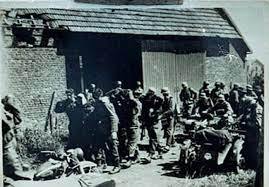
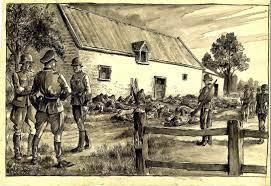
World War II: In the Le Paradis massacre, 99 soldiers from a Royal Norfolk Regiment unit are shot after surrendering to German troops; two survive.
0 notes
Photo

25th February 1794 General Sir James Murray was appointed Colonel of the Regiment, succeeding General Sir John Sebright. Murray changed his name to Pulteney for inheritance reasons on 22 July 1794, shortly before marrying his cousin Henriette Pultney in London. Murray was born about 1755, the son of Colonel Robert Murray, a Scottish soldier. He had his first commission purchased for him, in the 19th Foot, when he was still in his mid-teens in 1770. The following year he was a Captain in the 57th Foot, although he did not begin active soldiering until 1775. From 1776 to 1778 he served in America and was wounded twice, at the Battles of Brandywine and White Marsh. In 1778 he purchased a commission as Major in the 4th Foot with whom he served in the West Indies. Still only 25 he purchased the Lieutenant Colonelcy of the 94th Foot in 1780. In 1790 Murray was appointed Colonel and Aide de Camp to King George III. In the same year he was elected to the House of Commons as an MP. Murray served with the Grand Old Duke of York and his 10,000 men in Flanders in 1793 before being promoted to Major General in December. He was back in Holland as Lieutenant General in 1799, where he was once again wounded. By this time he was Pulteney, and he fought his last campaign in an attempt to capture the Spanish naval base at Ferrol in August 1800. Having served in a command in England, Pulteney was appointed Secretary at War in 1807. He died of complications after losing an eye in a hunting accident in Buckenham, Norfolk on 26th April 1811, having been Colonel of the 18th, Royal Irish for 17 years. #18thfoot #royalirishregiment Picture credit https://www.nationalgalleries.org/search/sitter/sir-james-murray-pulteney https://www.instagram.com/p/CpHrBYWtaBl/?igshid=NGJjMDIxMWI=
0 notes
Text
(Download) The Secrets We Left Behind - Soraya M. Lane
Download Or Read PDF The Secrets We Left Behind - Soraya M. Lane Free Full Pages Online With Audiobook.

[*] Download PDF Visit Here => https://forsharedpdf.site/56313269
[*] Read PDF Visit Here => https://forsharedpdf.site/56313269
How far will they go for family, friendship, and love?Occupied France, 1940. When the staff at a field hospital draw straws to find out who will join the evacuation from Dunkirk, Nurse Cate is left behind. But when the Nazis arrive to claim prisoners of war, she takes her chance and flees into the night, taking one patient with her.Fifty miles away, the surrendering soldiers of the Royal Norfolk Regiment are shot dead by the advancing Germans. Beneath the pile of bodies two men survive, crawling to the safety of a nearby farmhouse, where sisters Elise and Adelaide risk their lives to take them in. When Cate, too, arrives at their door with her injured soldier, the pressure mounts.The sisters are risking everything to keep their visitors safe. But with the Nazis coming ever closer and relationships in the farmhouse intensifying, they must all question the sacrifices they are willing to make for the lives of others. How far will they go for family, friendship, and love?
0 notes
Photo

Un soldat du 4e Bataillon du Royal Norfolk Regiment occupe une tranchée près d'une casemate à Great Yarmouth – Norfolk – Angleterre – 31 juillet-2 août 1940
©Imperial War Museums – H 2702
#WWII#Armée britannique#British Army#Royal Norfolk Regiment#Organisation défensive du Royaume-Uni#Défenses côtières#Tranchées#Casemate#Great Yarmouth#Norfolk#Angleterre#Grande-Bretagne#31/07/1940#02/08/1940
21 notes
·
View notes
Text
The Men Who Never Came Back
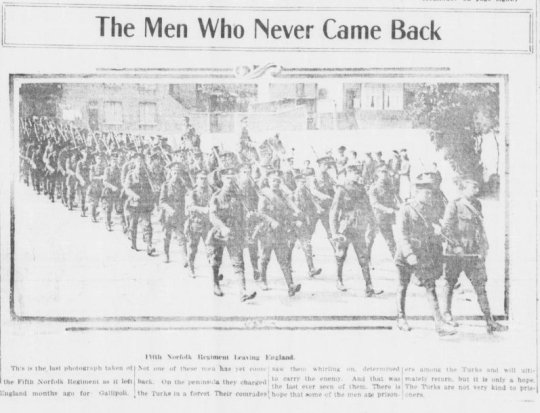
Article from East Oregonian : E.O., Feb 14 1916
Missing Men of the Royal Norfolk Regiment
On Aug 12 1915 the men of 1/5th Battalion, Royal Norfolk Regiment became isolated during battle in Gallipoli and suffered heavy casualties. Over time a legend grew that they marched into a mist and never returned.
They had in fact disappeared but it was due to industrial warfare not anything mysterious. Modern machine guns mowed them down when they bunched up in a targeted kill zone. Officers and some stragglers did make it back to the front lines under the cover of darkness.
25 notes
·
View notes
Text

• Bofors 40 mm gun
The Bofors 40 mm gun, often referred to simply as the Bofors gun, is an anti-aircraft autocannon designed in the 1930s by the Swedish arms manufacturer AB Bofors. It was one of the most popular medium-weight anti-aircraft systems during World War II, used by most of the western Allies.
The Swedish Navy purchased a number of 2-pounder Pom-Poms from Vickers as anti-aircraft guns in 1922. The Navy approached Bofors about the development of a more capable replacement. Bofors signed a contract in late 1928. Bofors produced a gun that was a smaller version of a 57 mm (6-pounder) semi-automatic gun developed as an anti-torpedo boat weapon in the late 19th century by Finspång. Their first test gun was a re-barreled Nordenfelt version of the Finspång gun, to which was added a semi-automatic loading mechanism. Testing of this gun in 1929 demonstrated that a problem existed feeding the weapon in order to maintain a reasonable rate of fire. A mechanism that was strong enough to handle the stresses of moving the large round was too heavy to move quickly enough to fire rapidly. One attempt to solve this problem used zinc shell cases that burned up when fired. This proved to leave heavy zinc deposits in the barrel, and had to be abandoned. In the summer of 1930 experiments were made with a new test gun that did away with controlled feed and instead flicked the spent casing out the rear whereafter a second mechanism reloaded the gun by "throwing" a fresh round from the magazine into the open breech. This seemed to be the solution they needed, improving firing rates to an acceptable level, and the work on a prototype commenced soon after.
During this period Krupp purchased a one-third share of Bofors. Krupp engineers started the process of updating the Bofors factories to use modern equipment and metallurgy, but the 40 mm project was kept secret. The prototype was completed and fired in November 1931, and by the middle of the month it was firing strings of two and three rounds. Changes to the feed mechanism were all that remained, and by the end of the year it was operating at 130 rounds per minute. Continued development was needed to turn it into a weapon suitable for production, which was completed in October 1933. Since acceptance trials had been passed the year before, this became known as the "40 mm akan M/32". Most forces referred to it as the "Bofors 40 mm L/60", although the barrel was actually 56.25 calibres in length, not the 60 calibres. The gun fired a 900 g (2.0 lb) high explosive 40 × 311R (rimmed) shell at 2,960 ft/s (900 m/s). The rate of fire was normally about 120 rounds per minute (2.0 rounds per second), which improved slightly when the barrels were closer to the horizon as gravity assisted the feeding from the top-mounted magazine. In practice firing rates were closer to 80–100 rpm (1.3–1.7 rounds per second), as the rounds were fed into the breech from four round clips which had to be replaced by hand. The maximum attainable ceiling was 7,200 m (23,600 ft), but the practical maximum was about 3,800 m (12,500 ft).
The gun was provided with an advanced sighting system. The trainer and layer were both provided with reflector sights for aiming, while a third crew-member standing behind them "adjusted" for lead using a simple mechanical computer. Power for the sights was supplied from a 6V battery. The first version of the 40 mm the Navy ordered was intended for use on submarines, where the larger calibre allowed the gun to be used for both AA and against smaller ships. The barrel was shorter at 42 calibers long, with the effect of reducing the muzzle velocity to about 700 m/s (2,300 ft/s). When not in use, the gun was pointed directly up and retracted into a watertight cylinder. The only known submarines that used this arrangement was the Sjölejonet-class boats. The guns were later removed. The first order for the "real" L/60 was made by the Dutch Navy, who ordered five twin-gun mounts for the cruiser De Ruyter in August 1934. These guns were stabilized using the Hazemeyer mount, in which one set of layers aimed the gun, while a second manually stabilized the platform the gun sat on. Bofors also developed a towable carriage which they displayed in April 1935 at a show in Belgium. This mount allowed the gun to be fired from the carriage with no setup required, although with limited accuracy. Orders for the land based versions were immediate, starting with an order for eight weapons from Belgium in August 1935, and followed by a flood of orders from other forces including Poland, Norway, and Finland. The Swedish Navy adopted the weapon as the m/36 in hand-worked single air-cooled, and power operated twin water-cooled version. A twin air-cooled mounting, probably hand-worked was also used by the navies of Sweden and Argentina and a twin air-cooled wet mounting was developed for Polish submarines.
The British Army had first examined the weapon when they received a number of Polish-built examples in 1937 for testing, known as the "QF 40 mm Mark I" (QF standing for "quick firing"), or "Mark I/2" after a minor change to the flash hider. A licence was acquired and the gun was converted from metric to imperial measurements. They also made numerous changes to the design to make it more suitable for mass production, as the original Bofors design was intended to be hand-assembled, and many parts were labeled "file to fit on assembly", requiring many man-hours of work to complete. Testing showed that aiming the guns against high-speed aircraft was a serious problem. Although the gun could be trained quickly, aiming accurately while doing so proved difficult. In order to address this, the British introduced a complex mechanical analogue computer, the Kerrison Director, which drove the laying electrically. A three-man team operated the director simply by pointing it at the target whilst dialing in estimates for speed, range, and various atmospheric conditions. The director then aimed the guns directly through powered mounts, as the gunners loaded the clips. This eliminated the need for the lead-correcting reflector sights, which were replaced with a backup system consisting of a simple ring-and-post sight known as a "pancake". In this form, the "QF 40 mm Mark III" (Mk II was a designation used for a Vickers "pom-pom"), became the Army's standard light AA (anti-aircraft) weapon, operating alongside their 3-inch and 3.7-inch heavy weapons. The gun was considered so important to the defence of Britain after the fall of France in 1940 that a movie, The Gun, was produced to encourage machinists to work harder and complete more of them. British production started slowly: by September 1939 only 233 equipments had been produced; but by the end of the war total production from British, Canadian and Australian factories was over 19,000. Peak production year was 1942 when British factories produced 5,025 and Canadian factories produced 1,311.
In combat it was found that the Kerrison was difficult to set up to use in many situations, as well as making logistics more complex due to the need to keep its electrical generator supplied with fuel. In most engagements only the pancake sights were used, without any form of correction, making the British versions less capable than those used by other forces. Eventually an anti-aircraft gunnery school on the range at Stiffkey on the Norfolk coast delivered a workable solution, a trapeze-like arrangement that moved the pancake sights to offer lead correction, operated by a new crew-member standing behind the left-hand layer. The "Stiffkey Sight" was sent out to units in 1943, arriving in Canadian units in the midst of the Battle of the Aleutian Islands. A final wartime change to the elevation mechanism resulted in the "QF 40 mm Mark XII". They also designed a much lighter two-wheeled carriage for airborne use. The Army also experimented with various self-propelled anti-aircraft systems based on various tank chassis. Changes to the breech for this role created the "QF 40 mm Mark VI", which was used on the Crusader to produce the Crusader III AA Mark I. The main self-propelled version of the Bofors used the gun set on the chassis of a Morris Commercial four-wheel drive lorry, this was known as the "Carrier, SP, 4x4 40mm, AA (Bofors) 30cwt". Such guns were used in support of Army divisions to provide swift protection against air attack without the need to unlimber. They saw service in North West Europe, where six SP Bofors of 92nd (Loyals) Light Anti-Aircraft Regiment, Royal Artillery, landed with the British 3rd Infantry Division on Sword Beach on D-Day to protect the vital bridges over the Caen Canal and Orne River (Pegasus Bridge and Horsa Bridge), shooting down 17 German planes. Later in the campaign, SP Bofors were used extensively for ground shoots as well as in an anti-aircraft role. In British army service the Bofors found a highly specialised role: during the North Africa Campaign at the Second Battle of El Alamein, they were used to fire tracer horizontally to mark safe paths for units through the German minefields. This practice was further developed during operations in North-West Europe, where bursts of colour-coded tracer were used to define the axis of advance of the different formations in large-scale night attacks.
The Royal Navy also made extensive use of the Bofors. Their first examples were air-cooled versions quickly adapted to ships during the withdrawal from Norway. Locally produced examples started arriving in 1942, known as the "QF 40 mm Mark IV" for use in twin-mounts, or the "QF 40 mm Mark V" for single mounts. The Navy ran through a variety of versions of the basic Bofors gun over the war, including the Mark VII to Mark XI. The Royal Navy's home-grown light anti-aircraft weapon, the QF 2-pounder gun, also had a caliber of 40 mm, but was referred to as the QF 2-pdr. The final British Bofors mounting that saw service was the "stabilized tachymetric anti-aircraft gun" (STAAG) which was twin-barrelled, stabilised, and carried its own tachymetric (i.e. predictive) fire control system, based around the centimeter Radar Type 262, capable of "locking on" to a target. This mounting was heavy (17.5 tons) and the high-vibration environment of the gun mounting was poor location for sensitive valve electronics and mechanical computers. STAAG Mark I carried the radar dish over the gun barrels where it was subject to damage during firing, therefore STAAG Mark II shifted the set to the roof of the control cabin. STAAG was ultimately too difficult to maintain in the harsh environment of a warship and was later replaced by the Mounting Mark V with the fire control equipment located remotely.
In order to supply both the U.S. Army and U.S. Navy with much greater numbers of the guns, Chrysler built 60,000 of the guns and 120,000 barrels through the war, at half the original projected cost, and filling the Army's needs by 1943. Over the lifetime of the production, their engineers introduced numerous additional changes to improve mass production, eventually reducing the overall time needed to build a gun by half; most of these changes were in production methods rather than the design of the gun itself. There were many difficulties in producing the guns within the United States, beyond their complexity (illustrated by the use of 2,000 subcontractors in 330 cities and 12 Chrysler factories to make and assemble the parts). The drawings were metric, in Swedish and read from the first angle of projection. Chrysler had to translate to English, fix absolute dimensions, and switch to the third angle of projection. Chrysler engineers also tried to simplify the gun, unsuccessfully, and to take high speed movies to find possible improvements, but this was not possible until near the end of the war. The United States Navy's Bureau of Ordnance purchased a twin-mount air-cooled example, spare parts and 3,000 rounds of ammunition directly from Bofors, which arrived in New York on August 28th, 1940 aboard the Army transport USAT American Legion, which had evacuated 897 people, including members of the Norwegian royal family, through the Finnish port of Petsamo. The gun was quickly chosen as the Navy's standard anti-aircraft weapon over the British 40mm calibre, 2-pounder pom-pom; however, negotiations with Bofors for licensed production stalled when the Swedes requested airplane export and manufacturing licenses in return. Reportedly, the Navy secretly imported a set of imperial designs from Britain and started production illegally. A formal contract with Bofors was reached in June 1941. The resulting Mark 1 and Mark 2 weapons were intended for the left and right side of a twin mount, respectively, and were adapted by Chrysler for water cooling.
Following the attack on Pearl Harbor on December 7th, 1941, the existing 1.1" (28 mm) quad mount and .50 caliber machine guns were determined to be inadequate against modern aircraft, and their replacement by 40 mm Bofors and 20 mm Oerlikon weapons was accelerated. The water-cooled version was used almost exclusively by the U.S. Navy and Coast Guard. In 1938 the United States Army introduced a 37 mm gun of their own design, but found it to be of limited performance. In early World War II, six British Bofors were imported for testing, along with Kerrison Predictor directors, and they proved to be superior in all areas. By the middle part of the war, most of the 37 mm guns had been replaced by the 40 mm. In U.S. Army and Marine Corps service, the single mount Bofors was known as the 40 mm Automatic Gun M1. The U.S. version of the gun fired three variants of the British Mk. II high-explosive shell as well as the M81A1 armor-piercing round, which was capable of penetrating some 50 mm of homogeneous armor plate at a range of 500 yards. In the Army, each Anti-Aircraft Artillery (AAA) auto-weapons battalion was authorized a total of thirty-two 40 mm guns in its four firing batteries. During World War II, the twin mount version of the gun was mounted on an M24 Chaffee tank chassis as the M19 Gun Motor Carriage. In the 1950s, the M41 Walker Bulldog tank was heavily modified into the M42 Duster with the same twin 40 mm mounting. After being largely withdrawn from service in the early 1960s, the M42 was re-introduced beginning in 1966 for the Vietnam War, where it was mostly used for ground fire support. The U.S Airforce created the Bofors 40 mm gun § AC-130 Gunship.
In World War II Germany, the Wehrmacht used a number of Bofors guns which had been captured in Poland and France. The Kriegsmarine also operated some guns obtained from Norway. In German naval use, the gun was designated the "4 cm Flak 28", and was used aboard the cruisers Admiral Hipper and Prinz Eugen toward the end of the war. Germany also purchased a large number (200+) of Hungarian made Bofors guns. In return, Hungary received 75 mm PAK guns for every 4-5 Bofors. Then Wehrmacht used Hungarian guns after German occupation of Hungary from late 1944. Most of them lost during the fights in Budapest and Trandanubia. Japan captured a number of Bofors guns in Singapore and put them into production as the Type 5. Both Japan and West Germany continued to use the Bofors gun throughout the Cold War. The Federal German navy used it in destroyers, frigates, and fast patrol boats until 1984, and in minesweepers to the present day.
The Bofors 40mm post-war service has endured through the cold war and into the modern era. In the post-war era, the original design was not suitable for action against jet-powered aircraft, so Bofors introduced a new model of significantly more power, the 40 mm L/70. In spite of sharing almost nothing with the original design other than the calibre and the distinctive conical flash hider, this weapon is also widely known simply as "the Bofors". Although not as popular as the original L/60 model, the L/70 remains in service, especially as a multi-purpose weapon for light armoured vehicles, as on the CV 90. Bofors has been part of BAE Systems AB since March 2005.
#second world war#world war ii#world war 2#military history#wwii#history#british history#american history#naval warfare#long post#military equipment#anti-aircraft gun#aviation
139 notes
·
View notes
Text


CATHERINE'S STYLE FILES - 2023
8 NOVEMBER 2023 || The Princess of Wales visited the 1st The Queen's Dragoon Guards regiment at the Robertson Barracks at Swanton Morley in Norfolk.
Catherine opted for -
↬ Twill Double Breasted Blazer in Black by Holland Cooper
↬ Black Turtleneck Sweater
↬ Black Skinny Trousers
↬ Teardrop Hoops with Garnet Charm Earrings by Spells of Love
↬ Paper Poppy Pin by Royal British Legion
↬ Leather Trimmed Suede Ankle Boots from See By Chloé
#catherines style files#style files 2023#royal fashion#fashion#style#princess of wales#the princess of wales#princess catherine#princess kate#8112023#1stQueensDragoonGuards23#british royal family#british royals#royals#royal#kate middleton#catherine middleton#duchess of cambridge#royalty#brf#british royalty#holland cooper.#spells of love.#royal british legion.#paper poppy pin.#teardrop garnet charm earrings.#chloé.#see by chloé.
17 notes
·
View notes
Text
13 July 2021
St James’s Palace
The Princess Royal, Colonel, The Blues and Royals (Royal Horse Guards and 1st Dragoons), this morning visited the Household Cavalry Mounted Regiment Summer Camp at Bodney Camp, Hilborough, near Watton, Thetford, Norfolk.
Her Royal Highness later attended a Dedication Ceremony of Le Paradis Memorial at Norwich Cathedral and was received by General the Lord Dannatt (Deputy Lieutenant of Norfolk).
The Princess Royal, Honorary Air Commodore, Royal Air Force Brize Norton, this afternoon received Group Captain Daniel James upon relinquishing his appointment as Station Commander and Group Captain Emily Flynn upon assuming the appointment.
Her Royal Highness, Patron, the Royal Navy and Royal Marines Charity, received Sir William Thomas upon relinquishing his appointment as Chairman and Dr Brian Gilvary upon assuming the appointment.
The Princess Royal, Royal Fellow, the Royal Academy of Engineering, this evening attended an Awards Reception at Prince Philip House, 3 Carlton Terrace, London SW1, and was received by Mr Kevin Traverse-Healy (Deputy Lieutenant of Greater London).
Court Circular
8 notes
·
View notes
Text
Missed opportunity in season 2 of HOA
Hear me out:
The collector’s identity has been hyped up all season. I was of the group that believed Vera was the collector and was disappointed when I saw her with the hooded collector. But what if another plot twist could be thrown into the story.
So here’s how it would go:
Jerome follows Jasper to the exchange between the doll and Trudy. We see Vera with the figure. But we also see something else. The hooded figure’s sleeve is pulled up and Jerome spots a tattoo on the figure's forearm. It’s an old war tattoo, from the 2nd Battalion of the Royal Norfolk Regiment, a division that fought in WWII, in France and served at Dunkirk. Obviously, he is confused and researches it. He speculates it might be victor. He says “think about it, who would want to collect anything and everything Frobisher, do whatever it takes to do it and works alongside Vera? And furthermore, who is the only person who would have the original tat, not just a recreation for their grandfather or something?”
It wouldn’t change much but I think it would’ve served as a fun twist and might have given Rufus more of a backstory. Maybe he saw things in the war and from there on out began to go downhill? Idk, I just think it might have been cool.
26 notes
·
View notes
Video
The Royal Norfolk Regiment por David Chandler
Por Flickr:
WD 2-10-0 90775 'The Royal Norfolk Regiment' climbs past Dead Man's Hill with the first train of the day yesterday morning.
7 notes
·
View notes
Text
Events 1.1 (before 1830)
153 BC – For the first time, Roman consuls begin their year in office on January 1.
45 BC – The Julian calendar takes effect as the civil calendar of the Roman Empire, establishing January 1 as the new date of the new year.
42 BC – The Roman Senate posthumously deifies Julius Caesar.
193 – The Senate chooses Pertinax against his will to succeed Commodus as Roman emperor.
404 – Saint Telemachus tries to stop a gladiatorial fight in a Roman amphitheatre, and is stoned to death by the crowd. This act impresses the Christian Emperor Honorius, who issues a historic ban on gladiatorial fights.
417 – Emperor Honorius forces Galla Placidia into marriage to Constantius, his famous general (magister militum) (probable).
947 – Emperor Tai Zong of the Khitan-led Liao Dynasty captures Daliang, ending the dynasty and empire of the Later Jin.
1001 – Grand Prince Stephen I of Hungary is named the first King of Hungary by Pope Sylvester II (probable).
1068 – Romanos IV Diogenes marries Eudokia Makrembolitissa and is crowned Byzantine Emperor.
1259 – Michael VIII Palaiologos is proclaimed co-emperor of the Empire of Nicaea with his ward John IV Laskaris.
1438 – Albert II of Habsburg is crowned King of Hungary.
1500 – Portuguese explorer Pedro Álvares Cabral discovers the coast of Brazil.
1502 – The present-day location of Rio de Janeiro, Brazil, is first explored by the Portuguese.
1515 – Twenty-year-old Francis, Duke of Brittany, succeeds to the French throne following the death of his father-in-law, Louis XII.
1527 – Croatian nobles elect Ferdinand I, Archduke of Austria as King of Croatia in the 1527 election in Cetin.
1600 – Scotland recognises January 1 as the start of the year, instead of March 25.
1604 – The Masque of Indian and China Knights is performed by courtiers of James VI and I at Hampton Court.
1651 – Charles II is crowned King of Scotland at Scone Palace.
1700 – Russia begins using the Anno Domini era instead of the Anno Mundi era of the Byzantine Empire.
1707 – John V is proclaimed King of Portugal and the Algarves in Lisbon.
1739 – Bouvet Island, the world's remotest island,[21] is discovered by French explorer Jean-Baptiste Charles Bouvet de Lozier.
1772 – The first traveler's cheques, which could be used in 90 European cities, are issued by the London Credit Exchange Company.
1773 – The hymn that became known as "Amazing Grace", then titled "1 Chronicles 17:16–17, Faith's Review and Expectation", is first used to accompany a sermon led by John Newton in the town of Olney, Buckinghamshire, England.
1776 – American Revolutionary War: Norfolk, Virginia is burned by combined Royal Navy and Continental Army action.
1776 – General George Washington hoists the first United States flag, the Grand Union Flag, at Prospect Hill.
1781 – American Revolutionary War: One thousand five hundred soldiers of the 6th Pennsylvania Regiment under General Anthony Wayne's command rebel against the Continental Army's winter camp in Morristown, New Jersey in the Pennsylvania Line Mutiny of 1781.
1788 – The first edition of The Times of London, previously The Daily Universal Register, is published.
1801 – The legislative union of Kingdom of Great Britain and Kingdom of Ireland is completed, and the United Kingdom of Great Britain and Ireland is proclaimed.
1801 – Ceres, the largest and first known object in the Asteroid belt, is discovered by Giuseppe Piazzi.
1804 – French rule ends in Haiti. Haiti becomes the first black-majority republic and second independent country in North America after the United States.
1806 – The French Republican Calendar is abolished.
1808 – The United States bans the importation of slaves.
1810 – Major-General Lachlan Macquarie officially becomes Governor of New South Wales.
1822 – The Greek Constitution of 1822 is adopted by the First National Assembly at Epidaurus.
0 notes

